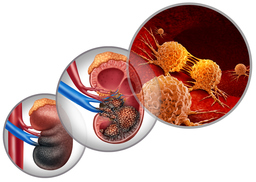Epithelial-Mesenchymal Transition-based Gene Expression Signature for Kidney Cancer
TECHNOLOGY NUMBER: 2022-045

OVERVIEW
A novel means to predict progression or recurrence of renal cell carcinoma- Delineates patients with poorer progression free survival and disease specific survival
- Prognostic score that improves risk stratification and provides new therapeutic targets
BACKGROUND
Renal cell carcinoma comprises about 4% of all newly diagnosed cancers in the United States and is most often treated with curative intent surgery. About 10% of patients present with locally advanced or metastatic tumor, and another 20% of patients treated for cure will suffer disease recurrence. Several genetic alterations have been associated with clear cell renal cell carcinoma (ccRCC), the most common histologic subtype of kidney cancer. While remodeling of ccRCC cellular metabolism correlates with higher grade disease that presents with a more advanced stage and lower chances for survival, molecular profiling is not routinely carried out to assess prognosis or to aid selection of therapy. A need exists to improve the understanding of the molecular underpinnings of renal cell carcinoma cases to identify those critical pathways that lead to greater risks for disease recurrence.
INNOVATION
Researchers at the University of Michigan have discovered the synergistic prognostic impact of two known predictors of renal cell carcinoma progression, namely epithelial-to-mesenchymal transition (EMT) and the cell cycle progression (CCP) score. EMT is a developmentally vital reversible process by which fully differentiated cells lose their epithelial features and acquire a migratory mesenchymal phenotype, while the CCP score has been shown to independently improve risk stratification of several other cancer types including those arising in the breast and prostate. The scientists performed differential expression gene (DEG) analysis on targeted RNA next-generation sequencing data from kidney cancer samples and documented a correlation with poorer progression free survival and disease specific survival through the combined measurement of these two factors. The predictive capabilities of this approach applied to both patients considered to have lower risk disease at presentation as well as those with known high-risk features, such as the presence of synchronous interior vena cava thrombus. The resulting prognostic score therefore provides the potential to improve risk stratification and provide potential novel therapeutic targets.